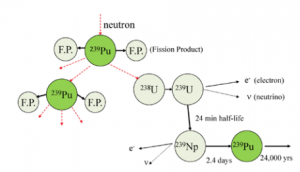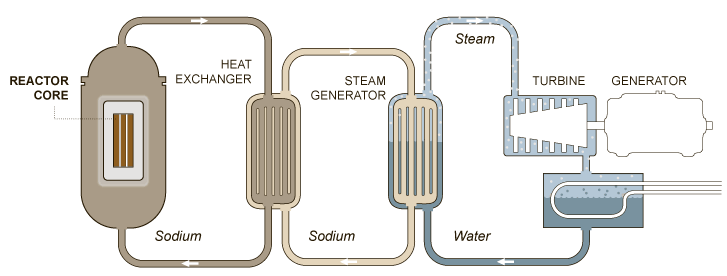Reaction
Like a traditional nuclear reactor a breeder reactor uses fission of nuclear materials to create energy. The biggest difference is that a plutonium breeder reactor produces more plutonium than it consumes. It does this by using its extra fission neutrons to convert uranium-238 to uranium-239, which changes by radioactive decays involving electron emission into neptunium-239 and then plutonium-239. [2]
This plutonium can then be used as fuel in subsequent cycles. According to a study in Robert A. Ristinen and Jack J. Kraushaar book, breeder technology could not only make harder to reach and lower grades of uranium and plutonium more economically attractive, but this could extend our nuclear resources for up to 50,000 years. [6]
How a Breeder Reactor Works
During a fission reaction high energy neutrons are produced which are moving very fast. A moderator or heat transfer material is then used to slow the neutrons down somewhat. The neutrons are not slowed as much as in a traditional reactor because they are rapidly captured by the uranium which then creates plutonium. The rest of the process is very similar to the traditional reactor following the above schematic. The most conventional breeder reactors use liquid metal, such as sodium or lead, to transfer the heat rather than traditional reactor that tend to use water. Other heat transfer materials include various gasses or even molten salt.[5]
Around the world
There are currently eight breeder reactors in use around the world. Another estimated 13 breeder reactors are in the works as well.[3] In depth research on these additional reactors showed various levels of planning and progress depending on the country. This uncertainty comes from many mixed feelings on the safety and reliability of these reactors as well as nuclear power generation in general. Another reason for the small number of breeder reactors worldwide compared to traditional reactors were various false assumptions made early on in research & development. These assumptions included: the scarcity of uranium resources, the economic competitiveness, various safety and reliability issues, and the proliferation risks that come with this technology.[1]
(Composed by Becca McIver, Edited by Dan Kervick, Sean Hanczor, & Ivan Basurto)
References
- Cochran, Thomas B., Harold A. Feiveson, Zia Mian, M.V. Ramana, Mycle Schneider, and Frank N. Von Hippel. “It’s Time to Give up on Breeder Reactors.” Bulletin of the Atomic Scientists (2010): 50-56. Princeton University, May-June 2010. Web. 20 Apr. 2015.
- Cochran, Thomas B., Harold A. Feiveson, Walt Patterson, Gennadi Pshakin, M.V. Ramana, Mycle Schneider, Tatsujiro Suzuki, and Frank Von Hippel. “Fast Breeder Reactor Programs: History and Status.” Research Report 8 International Panel on Fissile Materials (2010): 1-12. Feb. 2010. Web. 21 Apr. 2015.
- Fast Neutron Reactors. World Nuclear Association, 16 Mar. 2015. Web. 19 Apr. 2015.
- “How a Breeder Reactor Works.” The New York Times. 17 June 2011. Web. 19 Apr. 2015. Image
- Karam, P. Andrew. “How Do Fast Breeder Reactors Differ from Regular Nuclear Power Plants?” Scientific American Global. N.p., 17 July 2006. Web. 19 Apr. 2015.
- Ristinen, Robert A., and Jack J. Kraushaar. “The Promise and Problems of Nuclear Energy.” Energy and the Environment. 2nd ed. N.p.: John Wiley & Sons, 2006. 171-202. Print.
